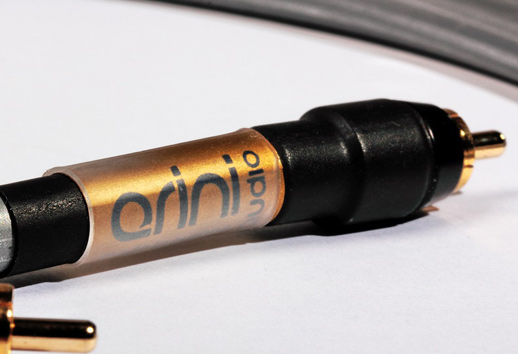 Test
Test
|
RCA Interconnect ariniAUDIO silverStarr Price (in Poland): 430 zł (0.8 m) Manufacturer: ariniAUDIO Contact: Paweł Panasewicz tel.: +48 887 091 940 e-mail: studio@ariniaudio.pl Country of origin: Poland Manufacturer's website: ariniAUDIO Text: Wojciech Pacuła Pictures: Wojciech Pacuła Translation: Krzysztof Kalinkowski |


Report published: ariniAUDIO (the company insists to have its name written like this) is the newest, known to me, Polish cable manufacturer. It turned out, that this is the third Polish cable company that just starts business and about which I learned this year. Let me remind you, that those were Sevenrods (HERE) and Audiomica Laboratory (HERE), both tested in the “Polish” edition of “High Fidelity” (No. 81. September 2011). 
The tested interconnect belongs to the cheapest cables I tested in “High Fidelity”. It is not the cheapest one, because the Monacor GAC-202 tested in 2004 cost 37zl (test HERE), but it cannot be denied, that among audiophile cables, made according to all the rules in the book, with listening sessions, etc, it is a bargain. Additional information from the manufacturer regarding the model silverStarr:

SOUND Recordings used for the listening sessions:
Japanese versions of the discs are available on CD Japan. |
SilverStarr is a cable with a nice, slightly softened sound. At the same time this is a cable which does not have a muffled or fogged sound. Its low price is reflected most of all in homogenized sound, blunting of the attack and shortening of the reverb. This all just means that the resolution is lower. But this does not define the cable as it is – we cannot really hear that we deal with a budget cable – and this is always a good sign. 
The most important thing is what I started with, and what is often missing in budget systems: the cable sounds in an incredibly coherent way. Its sonority is surprising, because knowing, that this is silver covered copper, knowing its price I expected – how to say that – something more primitive, dry and thin. And I got something completely different, this cable does not make the sound thinner. Yes, the middle bass is not as strong, as saturated as in more expensive, good cable, but it is not really disturbing, I would be surprised, when somebody would mention that as a weakness. With Audiofeels, and later with The Gospel Truth Ida Sand, and also Magnetic Fields Jarre we could also hear another asset of the Polish cable – nicely built bass and its transition to the midrange. Like I said, the sound is slightly soft, what helps in building large virtual sources. This is a part of not thinning the sound, so common not only on this price level. Bass is strong and well developed. It has the role of an “anchor” connecting the sound with the “soil”, placing it on stage. Differentiation of this subrange is nice and does not deviate from what we can get for the money. The cable sounds nice, in a big way, delicately handling the musical matter. Resolution is not exceptional, but it will not be heard with budget gear, electronics and loudspeakers will have much bigger issues. I think that the silverStarr will fit in any well balanced system, in places where a Supra cable would also be a good match. The Polish interconnect will be more dynamic and slightly more open, but the timbre will be very similar. An inexpensive, fantastic proposition for those people, who enter now the incredible world of sound. It will be a good start with the silverStarr. 
CONDITIONS AND METHODOLOGY The silverStarr cable was placed in my reference system, connecting the Ancient Audio Lektor Air V-Edition player and preamplifier Ayon Audio Polaris III. In a part of the session I also used DACs, which I tested in parallel for “Audio”. Those were: Music Hall dac25.3, Advance Acoustic MDX-600, Hegel HD20 and Blacknote DAC30. Especially good was the combination with organic sounding, saturated DACs from Music Hall and Hegel. With the quite bright AA and open (this is not the same) Blacknote the ariniAUDIO cable withdrew the treble nicely, but it did not convert it to something so exquisite as in the Hegel. Listening sessions were made in the schematics A/B/A and B/A/B with known A and B, using 2 minute long sound pieces. Quick switching between A and B did not lead to any sensible conclusions – differences could be heard, the better cable could be indicated, but the sound of each of them could not be described. This is why I do not use double blind A/B/X testing. The Polish interconnect was compared to the reference, the Acrolink Mexcel 7N-AD6300 (27 900zł/1m), and in the listening sessions with the DACs I also used the cable Oyaide Tunami Terzo RR (1490zł/ m). It turned out, that the arniAUDIO has the sound character very similar to the Oyaide. The cable silverStarr is very flexible and is very easy to place in a system. The packaging is nice and without special glamour. |
||||

|
|||||
ASSOCIATED EQUIPMENT
|
main page | archive | contact | kts
© 2009 HighFidelity, design by PikselStudio,
projektowanie stron www: Indecity











